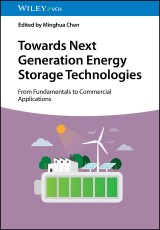Details

Towards Next Generation Energy Storage Technologies
From Fundamentals to Commercial Applications1. Aufl.
|
142,99 € |
|
| Verlag: | Wiley-VCH (D) |
| Format: | EPUB |
| Veröffentl.: | 04.09.2024 |
| ISBN/EAN: | 9783527845309 |
| Sprache: | englisch |
| Anzahl Seiten: | 480 |
DRM-geschütztes eBook, Sie benötigen z.B. Adobe Digital Editions und eine Adobe ID zum Lesen.
Beschreibungen
<p><b>Develop the clean technologies of the future with these novel energy storage technologies</b> <p>Energy storage is a crucial component of the broader battle to develop clean energy sources and transform the power grid in light of advancing climate change. Numerous new energy storage technologies based on electrochemical redox reactions have recently been developed or proposed, promising to reduce costs and enable energy-dense devices and applications of many kinds. This urgent work demands to be incorporated into chemistry, materials science, and industry at every level. <p><i>Towards Next Generation Energy Storage Technologies </i>offers a comprehensive overview of these novel technologies and their applications. Beginning with an introduction to the fundamentals of electrochemistry and energy storage, it offers current and future research questions, design strategies, and much more. It is a must-own for scientists and engineers looking to develop the energy grid of the future. <p><i>Towards Next Generation Energy Storage Technologies</i> readers will also find: <ul><li>Summaries of state-of-the-art research and open challenges</li><li>Detailed discussion of technologies including lithium-ion batteries, all-solid-state batteries, aqueous multi-valence energy storage systems, and more</li><li>Discussion of applications including electric vehicles, aerospace devices, and many others</li></ul> <p><i>Towards Next Generation Energy Storage Technologies</i> is ideal for materials scientists, inorganic chemists, electrochemists, electronics engineers, and anyone working on the clean energy grid or electrical devices.
<p>Preface xiii</p> <p>Acknowledgments xv</p> <p><b>1 Introduction 1</b><br /><i>Minghua Chen and Yu Li</i></p> <p><b>2 Fundamentals of Electrochemical Energy Storage Technologies 3</b><br /><i>Minghua Chen and Yu Li</i></p> <p>2.1 Typical Battery Patterns and Corresponding Functions 3</p> <p>2.2 Operating Mechanism of Devices 7</p> <p>2.3 Critical Parameters and Design Proposal 15</p> <p>2.4 Common Investigation Technologies 17</p> <p>2.5 Common Design Strategies for High-Performance Electrode Materials 21</p> <p><b>3 Lithium-Ion Batteries 31</b><br /><i>Yu Li and Minghua Chen</i></p> <p>3.1 Brief Introduction 31</p> <p>3.2 Cathode Materials 33</p> <p>3.3 Anode Materials 39</p> <p>3.4 Application and Critical Challenges 46</p> <p><b>4 Sodium-Ion Batteries 55</b><br /><i>Huihua Li and Hongxu Qv</i></p> <p>4.1 Introduction 55</p> <p>4.2 Energy Storage Mechanism 56</p> <p>4.3 Cathode Materials 57</p> <p>4.4 Anode Materials 87</p> <p>4.5 Electrolyte 103</p> <p>4.6 Sodium-Ion Batteries at Extreme Temperatures 107</p> <p>4.7 Other Na-Based Technologies 109</p> <p>4.8 Summary and Outlook 115</p> <p><b>5 All-Solid-State Batteries 137</b><br /><i>Yixin Wu, Yang Wang, Zhen Chen, and Minghua Chen</i></p> <p>5.1 Introduction 137</p> <p>5.2 Ion Transport Mechanism 139</p> <p>5.3 Key Performance Parameters 143</p> <p>5.4 Classification of Solid Electrolytes 146</p> <p>5.5 Practical Problems and Critical Challenges 186</p> <p>5.6 Practical Advances in Electric Vehicles and Other Areas 193</p> <p><b>6 Lithium-Sulfur Battery 211</b><br /><i>Saisai Qiu and Minghua Chen</i></p> <p>6.1 Fundamental Understanding of Li-S Batteries 214</p> <p>6.2 Sulfur Cathode 217</p> <p>6.3 Electrolyte 224</p> <p>6.4 Anode 234</p> <p>6.5 Li-S Pouch Cell Analysis 239</p> <p><b>7 Aqueous Multivalent Metal Ion Batteries: Fundamental Mechanism and Applications 249</b><br /><i>Xingyu Zhao, Chunyang Yang, and Minghua Chen</i></p> <p>7.1 Introduction 249</p> <p>7.2 Classification Based on Energy Storage Mechanism 250</p> <p>7.3 Highly Stable and Energetic Cathodes 257</p> <p>7.4 Strategies for Dendrite-Free Metal Anodes 262</p> <p>7.5 Strategies for Designing Electrolytes 265</p> <p>7.6 Design Strategies for Extreme Temperatures 273</p> <p>7.7 Practical Progress in Grid-Scale Energy Storage and Wearable Devices 281</p> <p><b>8 Li-O2 and Li-CO2 Batteries 289</b><br /><i>Fan Wang and Minghua Chen</i></p> <p>8.1 Introduction 289</p> <p>8.2 The Mechanism for Li-O2 and Li-CO2 Batteries 291</p> <p>8.3 Design Strategy of Cathode Materials 300</p> <p>8.4 Electrolyte and Electrolyte Stability 312</p> <p>8.5 Stable Anode/Electrolyte Interface Construction 320</p> <p>8.6 Application Potential Analysis 323</p> <p><b>9 Supercapacitors 331</b><br /><i>Jiawei Zhang and Minghua Chen</i></p> <p>9.1 Brief Introduction 331</p> <p>9.2 Energy Storage Mechanism 331</p> <p>9.3 Electrode Materials 341</p> <p>9.4 Electrolytes 354</p> <p>9.5 Conclusion 362</p> <p><b>10 Battery-Supercapacitor Hybrid Devices 369</b><br /><i>Jiawei Zhang, Mingxing Zhang, and Minghua Chen</i></p> <p>10.1 Introduction 369</p> <p>10.2 Classification Based on Energy Storage Mechanism 370</p> <p>10.3 Key Scientific Problems 374</p> <p>10.4 Electrode Materials 382</p> <p>10.5 Microgrid Energy Storage 387</p> <p>10.6 Summary and Perspectives 389</p> <p><b>11 Fuel Cells 395</b><br /><i>Yuqing Wang and Minghua Chen</i></p> <p>11.1 Overview 395</p> <p>11.2 Thermodynamics and Kinetics 399</p> <p>11.3 Proton Exchange Membrane Fuel Cells 409</p> <p>11.4 Alkaline Fuel Cells 423</p> <p>11.5 Other Fuel Cells 434</p> <p>11.6 Fuel Cell Systems 437</p> <p>References 442</p> <p>Index 449</p>
<p><b>Minghua Chen, PhD,</b> is Associate Dean of the School of Electrical and Electronic Engineering at Harbin University of Science and Technology and Deputy Director of Key Laboratory of Engineering Dielectric and Applications, Ministry of Education, China. He has published widely on energy storage and conversion and related topics.</p>
<p><b>Develop the clean technologies of the future with these novel energy storage technologies</b> <p>Energy storage is a crucial component of the broader battle to develop clean energy sources and transform the power grid in light of advancing climate change. Numerous new energy storage technologies based on electrochemical redox reactions have recently been developed or proposed, promising to reduce costs and enable energy-dense devices and applications of many kinds. This urgent work demands to be incorporated into chemistry, materials science, and industry at every level. <p><i>Towards Next Generation Energy Storage Technologies </i>offers a comprehensive overview of these novel technologies and their applications. Beginning with an introduction to the fundamentals of electrochemistry and energy storage, it offers current and future research questions, design strategies, and much more. It is a must-own for scientists and engineers looking to develop the energy grid of the future. <p><i>Towards Next Generation Energy Storage Technologies</i> readers will also find: <ul><li>Summaries of state-of-the-art research and open challenges</li><li>Detailed discussion of technologies including lithium-ion batteries, all-solid-state batteries, aqueous multi-valence energy storage systems, and more</li><li>Discussion of applications including electric vehicles, aerospace devices, and many others</li></ul> <p><i>Towards Next Generation Energy Storage Technologies</i> is ideal for materials scientists, inorganic chemists, electrochemists, electronics engineers, and anyone working on the clean energy grid or electrical devices.


















